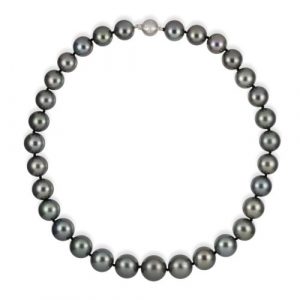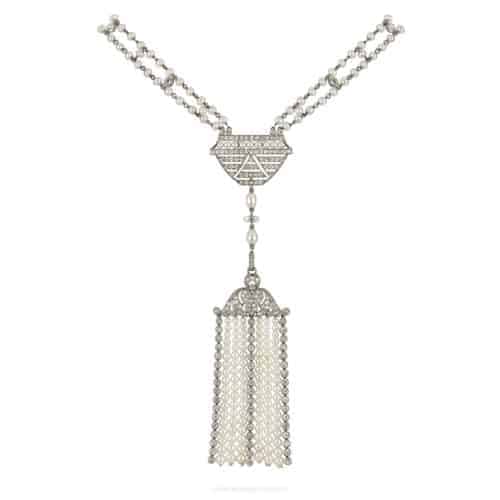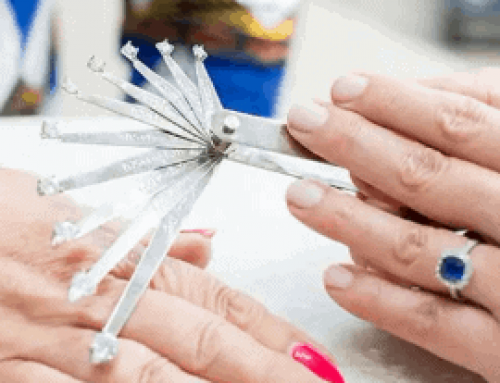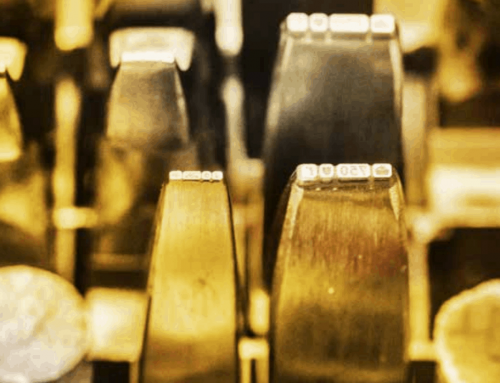June Birthstone – Pearls
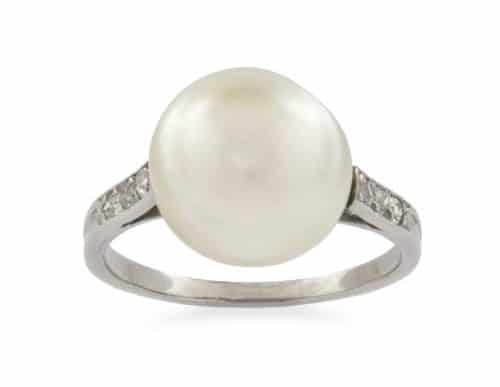

A Bouton Shaped Pearl Ring With Diamond Set Shoulders
Image Credit: Bentley & Skinner
The Queen of Gems
The allure of pearls is eternal and universal; they are a timeless wardrobe staple, beloved by women of all ages for thousands of years. A gift from the sea, the world’s first gems, emerge from their watery homes without the need for cutting, faceting or polishing. I like to compare them to the allegoric perfection and beauty of Botticelli’s the Birth of Venus…
Created by molluscs, they are treasures from every part of the world; fresh and salt water, living in lakes, rivers and streams, in great oceans as well as bays, inlets, lagoons and atolls. Throughout history a natural pearl necklace comprised of matched spheres was a treasure of almost incomparable value – in fact it was the world’s most expensive jewellery.
Their Historical Allure
First mentioned in 2206 BC by a Chinese historian, natural pearls have been coveted as symbols of wonder, wealth and status for thousands of years. Ancients from the Middle East believed that pearls were teardrops fallen from heaven. The Chinese fancied that the June birthstone came from the brain of a dragon. Christopher Columbus and his contemporaries thought that molluscs formed pearls from dew drops. In religious and secular texts, pearls became almost universal symbols of beauty and value. India’s sacred books and epic tales abound with pearl references. One enduring myth names the gift from each element worthy of the deity: the air offered the rainbow, fire a meteor, earth a ruby and the sea a pearl.
The spherical shape of some pearls led many cultures to associate this gem with the moon. In ancient China, pearls were believed to guarantee protection from fire and fire-breathing dragons. In Europe, as they have always embodied the mystery, power and life-sustaining nature of water, pearls therefore have long been associated with purity, humility and innocence. So it may be said that the meaning of the June birthstone is ‘sweet simplicity’ and, as such, pearls were traditionally given as a wedding gift.
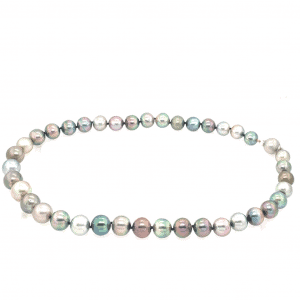
Pearl Necklace
Wedding Blog – Something Old, Something New
Sources and Occurrence
For at least 5,000 years some of the outstanding sources of natural pearls were the Persian Gulf, the waters of Ceylon (now Sri Lanka) and the rivers of Europe.
During Christopher Columbus’ voyages to the New World, he repeatedly encountered native people adorned with natural pearls. His discovery of natural pearl sources in the waters of present-day Venezuela and Panama intensified demand in Europe. By the mid 16th century the most popular royal jewel was the pearl, as illustrated by portrait paintings of Queen Elizabeth I, literally dripping in this display of beauty, wealth and status. Before the creation of cultured pearls in the early 1900s natural pearls were so rare and expensive they were reserved for only the noble and extremely rich.
The Invention of Cultured Pearls
Until the 20th century relatively little changed in the pearl market, from the discovery of the new world until the development of the cultured pearl. Experiments with cultivation had occurred for hundreds of years, however – in China and Japan pioneers successfully produced whole cultured pearls around the beginning of the 20th century. By the end of the 19th century an Australian named William Saville-Kent and three Japanese ‘inventors’ discovered techniques for culturing pearls. In 1916 one of these inventors – Kokichi Mikimoto – patented a technique to produce round pearls. These became commercially important in the 1920s.
It is about the same time that natural pearl production began to decline as over fishing led to the depletion of the oyster population. By the middle of the century, industrialisation, the discovery of oil in the Persian Gulf and pollution contributed to a further decline. From the 1930s to the 1980s, pearl culturing diversified and spread to various countries around the world; today improved techniques continue to be developed.
Only very small quantities of natural pearls are found in any of these areas today so they are rarer than ever before. Commanding staggering prices, they are sought after by collectors and connoisseurs – for most of us it’s only via museums and portraits of the rich and famous that we can enjoy them.
Thankfully however, Mikimoto and his cultured pearl changed the pearl market forever, allowing a new chapter of accessibility, enjoyment and ownership. Today for those desiring beautiful pearls, it’s fine cultured pearls they seek.
What is a pearl?
Pearls are organic gems that grow inside the tissue of a living saltwater or freshwater mollusc (either an oyster or a mussel).
Categories of Pearls:
- Natural – Produced entirely by natural processes
- Cultured – Deliberately initiated and farmed by man
- Simulated – imitate the appearance of natural and cultured pearls with a manufactured coating applied to a bead
Natural Pearls
Natural pearls form when the mollusc secretes a substance called nacre around an irritant such as a piece of sand or a parasite that has invaded its shell. Each layer of nacre represents one season’s growth. Thousands of years of pearl fishing have decimated the natural pearl beds, so cultured pearls account for the vast majority of pearl sales today. Now, commercially, cultured pearls are of far greater importance than natural pearls.
A Fine Edwardian Natural Pearl And Diamond Necklace/ Brooch
Image Credit: Bentley & Skinner
Cultured Pearls
Cultured pearls are a product of human intervention. Technicians implant a piece of mantle tissue alone (common for freshwater cultured pearls) or with a mother-of-pearl shell bead (all saltwater) into a host mollusc. The mollusc covers the irritant with nacre, just like a natural pearl. Cultured pearls are raised in saltwater or freshwater pearl farms, where the molluscs are cleaned, protected from predators and eventually harvested. Crucially, pearl-bearing molluscs won’t thrive in polluted waters, so pearl farms are usually located far from civilisation.
There are four major types of cultured whole pearls:
- Akoya cultured pearls
- South Sea cultured pearls
- Tahitian cultured pearls
- Freshwater cultured pearls
Akoya Cultured Pearls
Produced by the Akoya oyster, Akoya cultured pearls are the most familiar saltwater cultured pearls to people in the US and other western markets, used, for example, classic single strand necklaces. The farms are mostly found in Japan and China, especially along the southern coasts. These smaller white cultured pearls range from 2.5 to 11mm; anything over 8mm is rarer so more costly.
Akoya Pearl Necklace With Diamond Clasp
Image Credit: Bentley & Skinner
South Sea cultured pearls
South Sea cultured pearls are from larger species of oysters reared in localities around the Pacific such as the northern coast of Australia, the islands of Indonesia and the South Pacific, Philippines and China. They range in size from 8– 16mm – 13-15mm being the average and can be white to silver or golden, depending on the type of oyster.
Tahitian Cultured Pearls
These black and grey iridescent pearls are produced by black-lipped oysters. The Gambier Islands and the Tuamotu Archipelago, both part of French Polynesia, are two locales where these pearls are cultured. They are sometimes referred to as black pearls, but in fact have a wide colour range from grey, black or brown, and they can have blue, green, purple or pink overtones.
Freshwater Cultured Pearls
Some types of freshwater bivalves produce pearls; freshwater cultured pearls are the most commonly produced pearls and are among the most popular pearl types with shoppers and jewellery designers. This is due to their remarkable range of sizes, shapes and colours, as well as their pocket-friendly price points. They are usually cultured in freshwater lakes and ponds, often with many pearls grown in one oyster. In the past they were fished from rivers in most European countries, but today China is the leading source for freshwater cultured pearls.
Other Pearls
Non-nucleated pearls
In Japan and China freshwater bivalves are used to produced non-nucleated cultured pearls up to around 7.5mm in diameter. Small pieces of live mantel tissue are inserted into the mantle of the host mussel and the pearl sac grows around it. The resulting pearls have a bright lustre with shapes that are rarely round – usually buttons and long ovals. The production time of around just three years and each mussel hosting up to 30 pearls a time, makes these cultured pearls very affordable.
Seed Pearls
Seeds pearls are very tiny, round natural pearls, from freshwater or saltwater molluscs, usually under 2mm in size. They are rare today but often seen in antique jewellery and sometimes cut in half to create a greater supply or to remove blemishes.
Mabé Pearls
A mabé pearl is a domed shape pearl available in a variety of shapes, the most common being round or pear shaped. A domed shaped piece of plastic or mother of pearl is inserted against the inner side of the shell, which is then covered by nacre. The dome is then cut out, the plastic removed and filled with resin; the base can be covered by a polished mother-of-pearl backing. These are relatively inexpensive for a large, attractive look. They are however, more fragile than other pearls, so should be handled with care.
Keshi Pearls
Keshi, from the Japanese word meaning very small pearls, also called ‘chance’ pearls, are interesting baroque pearls accidently produced in saltwater oysters used for cultured pearl production. Occasionally the oyster rejects its bead implant, but particles of the accompanying mantle tissue used alongside the bead remain, these stimulate the production of nacre creating the keshi.
Imitation Pearls
Imitation pearls may be beads of glass, plastic or occasionally mother-of-pearl coated with a material known as guanine, which comes from herring fish scales. These crystals are removed and suspended in a lacquer; the coating is sometimes referred to as ‘essence d’orient’.
Treatments
Various treatments are widely used to enhance a pearl’s appearance: staining to improve colour, soaking in dye, irradiation for a grey-to-black colour or mild bleaching. Skinning, the removal of successive layers of nacre to improve their shape, colour, lustre or remove marks, requires a specialist skill and is very risky. It was historically undertaken by pearl doctors.
A famous pearl – La Peregrina
One of the most famous natural pearls is the 50.56 carat La Peregrina. About the size of a pigeon’s egg, the drop shaped pearl was discovered in the 1500s in the Gulf of Panama and became a prized possession of European royalty. The British actor Richard Burton eventually gifted it to US actress Elizabeth Taylor in 1969; Christie’s New York auctioned the Cartier necklace containing La Peregrina for $11.8 million in 2011.
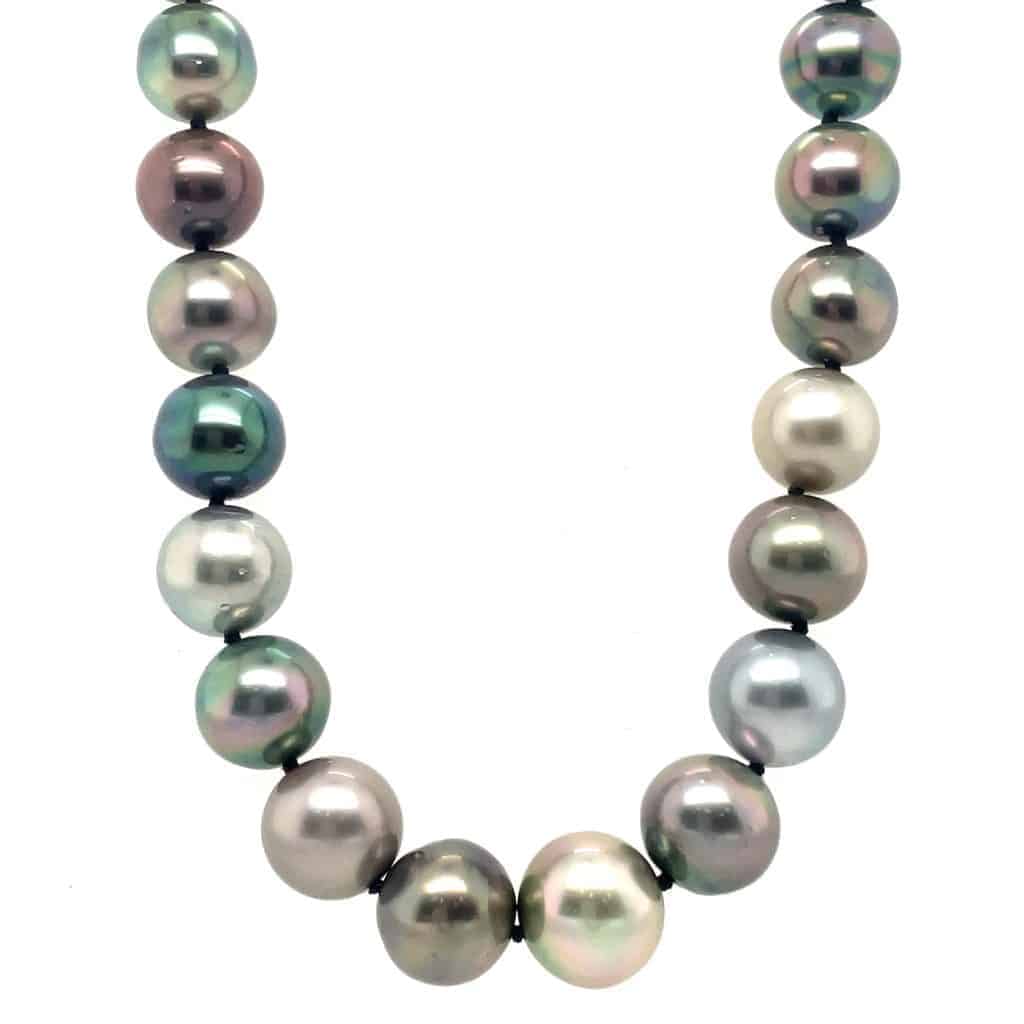
Pearl Necklace
Pearl quality
Regardless of the type of pearl, many factors are evaluated for its beauty and value:
- Lustre and orient
- Nacre thickness and quality
- Surface perfection
- Shape
- Size
- Colour
- Matching
Lustre and Orient
Lustre is the brightness that results from the rays of light travelling through the numerous layers of nacre and being reflected back from within the pearl. Pearls are valued for their high lustre (their sheen or soft glow); the higher the mirror-like finish the more desirable, as opposed to flat lustres.
Nacre thickness and quality
Lustre and nacre quality are closely related; nacre thickness and its quality have the greatest impact on the beauty of the pearl. The thicker the nacre the longer the life of the pearl; a less durable thin nacre means a shorter life. However, the quality of the nacre is equally important, because of how the light travels through the layers. It’s the combination of these factors that is crucial.
Surface quality
A smooth and clean surface is more desirable than a low blemished surface. Like coloured stones most pearls are rarely perfect. Some might show abrasions that look like surface scratches, or a flattened section, or an irregular ridge that looks like a crease or wrinkle. Numerous or severe ‘flaws’ can affect the pearl’s durability, lowering its value.
Shape
There are three shape categories:
* Spherical
* Symmetrical
* Baroque
The more perfectly spherical, the more valuable and the more popular (perhaps thanks to cultured pearls) but many depart from this shape and fashion, taste or trends also play a part in their desirability. Pear or drop shaped pearls are also highly prized. Highly irregular shaped pearls are called baroque pearls.
Colour
Pearl colour can have three components:
- Body colour is the pearl’s dominant overall colour
- Overtone is one or more translucent colours that lie over a pearl’s body colour
- Orient is a shimmer of iridescent rainbow colours on, or just below, a pearl’s surface
All pearls display body colour, but only some show overtone, orient or both.
Natural and cultured pearls occur in a broad range of hues and have a wide range of tone from light to dark. Pearl colours tend to be muted, with a soft, subtle quality. Broadly, body colours can be white, pink, yellow, grey, bronze, green, mauve and black. In addition, the orient may show delicate tints of pink, yellow, green or blue.
The value of certain pearl colours is all about the law of supply and demand. If supplies of high-quality pearls in a preferred colour are low, their prices can rise enormously. Other factors, like fashion trends and cultural traditions, can influence colour preferences. Or maybe a personal or regional preference – pink pearls are popular in America, cream and gold in the middle East and South America, while In Europe and the UK it’s all about classic cream or white.
Size
Natural pearls are sold by weight, today normally carat weight. Cultured pearl prices and desirability increase with size, measured in millimetres. When other value factors are equal, larger pearls are rarer and more valuable than smaller pearls of the same type.
Matching
For pearl strands and multi-pearl pieces, how well the pearls match (or mix) affects their value. Jewellery designers sometimes deliberately mix colours, shapes and sizes for unique effects, but for most pearl strands, earrings or other multiple-pearl jewellery, the pearls should match in all the quality factors.
A Belle Epoque natural pearl and diamond sautoir necklace
Image Credit: Bentley & Skinner
Care of Pearls
Pearls’ structure make them very durable, but they are a comparatively soft gem and require special care. Here are some important guidelines:
- Store them separately from other gemstones and metal jewellery to prevent scratching. Never store in a plastic bag as the plastic can emit a chemical that will damage their surface, instead use a soft pouch.
- Avoid exposure to vinegar, ammonia and chlorine bleach of any kind – like hairspray, perfumes and cosmetics. Pearls should be the last thing you put on and the first thing you take off, so always apply perfume, hair products and cosmetics before putting on your pearl jewellery.
- After wearing, clean your pearls with a soft, damp cloth, ideally after each time the pearls are worn. Never use an ultrasonic cleaner.
- Periodically, gently wash your pearls in warm mild soap (not detergent), use a soft brush to clean the knots of the settings and rinse them in clean water. Allow them to dry wrapped in a clean damp cotton towel (or wrung out kitchen towel). When the towel is dry so are the pearls.
- Avoid excesses of heat when storing; pearls like moist environments. Therefore, be careful of safety deposit boxes which are very dry; if needed place a damp (not wet) cloth with the pearls, check and re-dampen when necessary.
- Have your pearls restrung – once a year if worn frequently. Ideally string with knots which stops the pearls from rubbing each other (damaging the nacre) and prevents any losses if the silk breaks and the pearls scatter.


